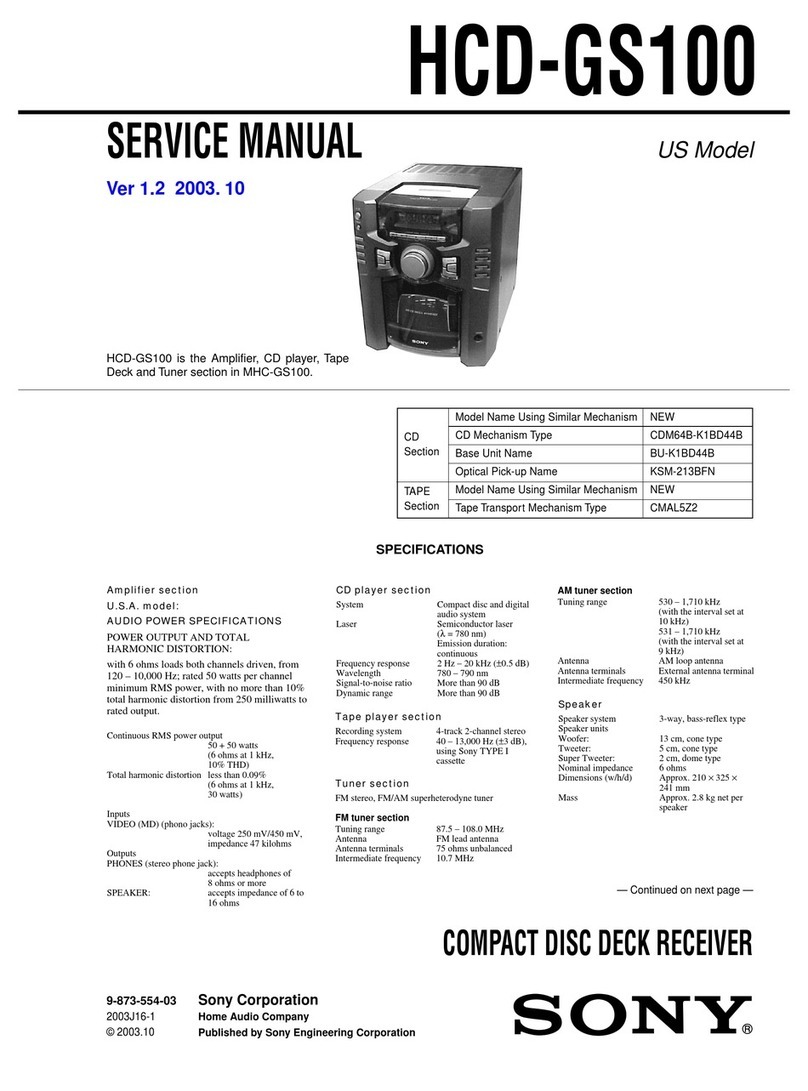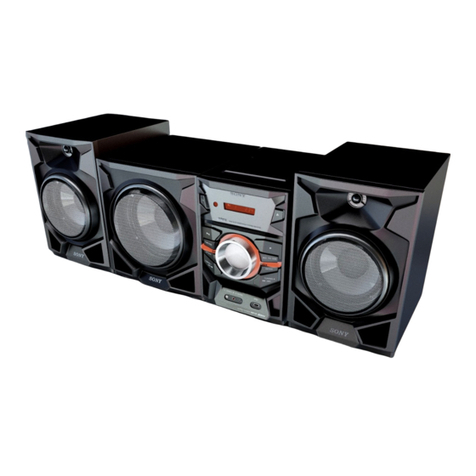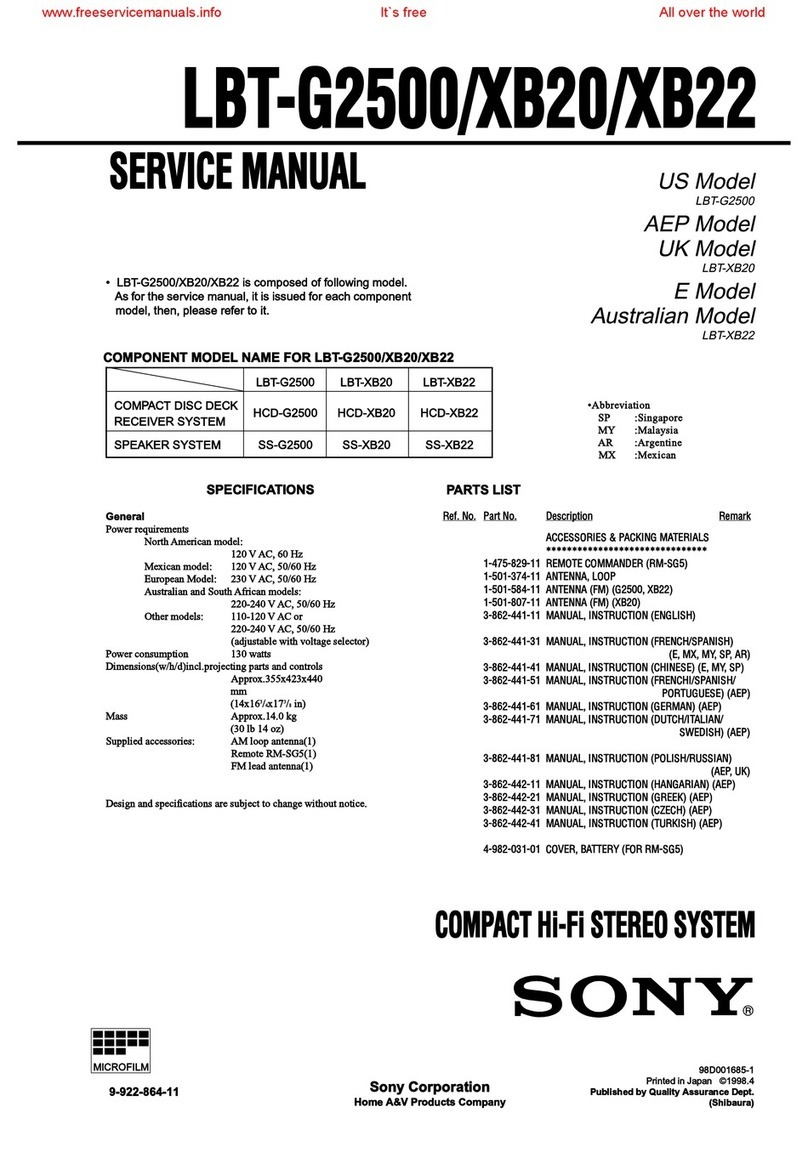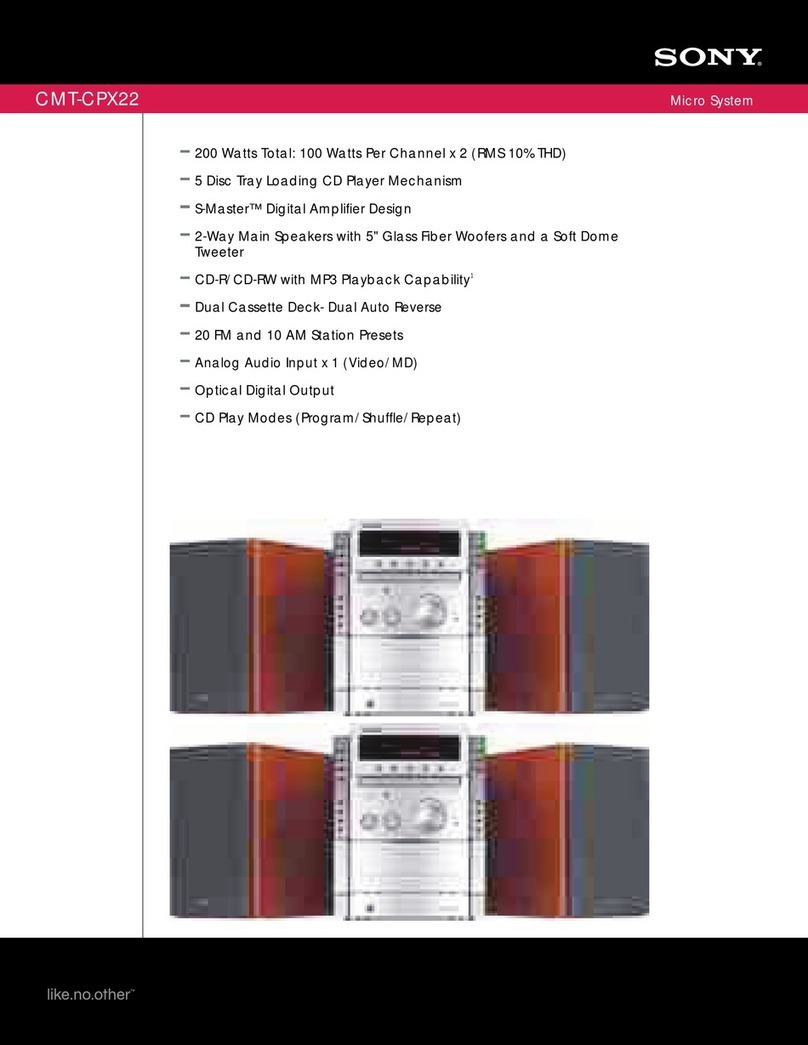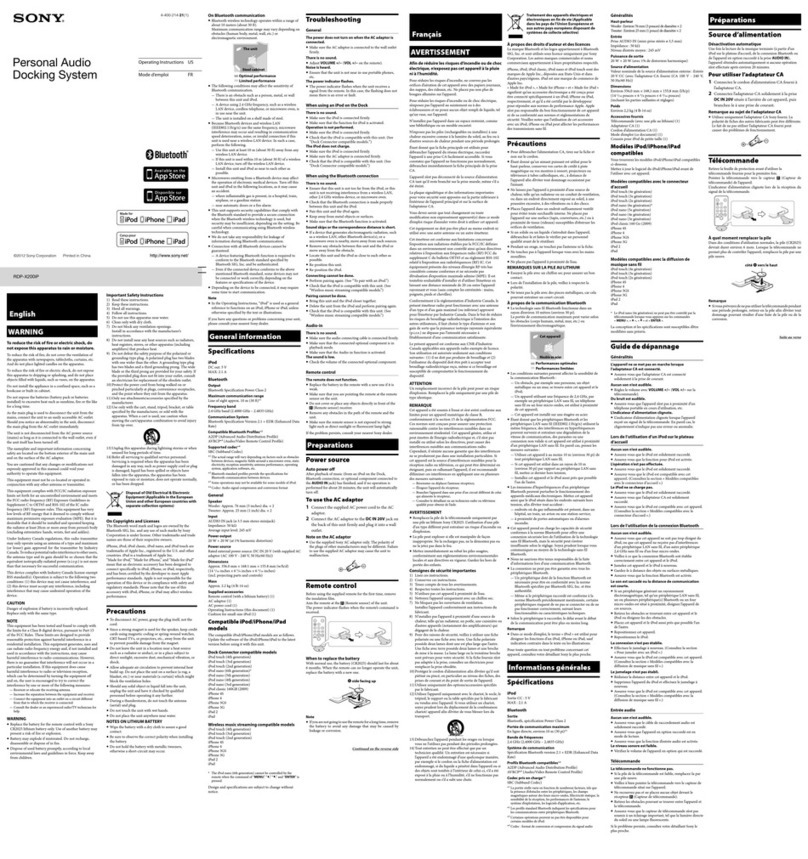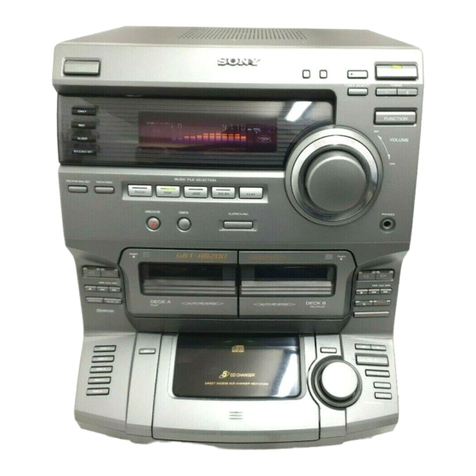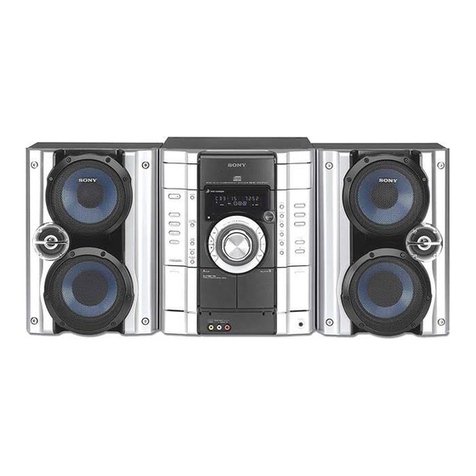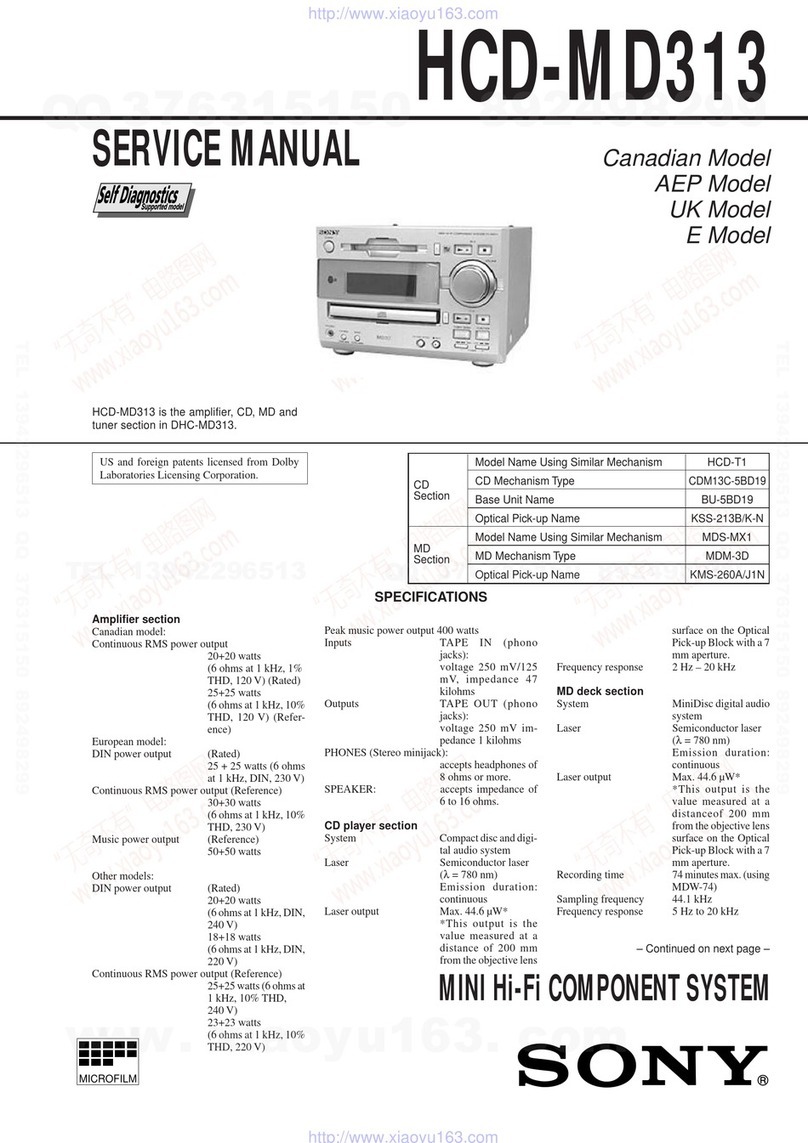CMT-GB3.GB.2-674-874-12(1)
Creating your own CD program
(Program Play)
Use buttons on the remote to create your own program.
1 Press CD to select the CD function.
2 Press PLAY MODE repeatedly until “PGM”
appears while the player is stopped.
3 Press DISC SKIP to select a disc.
4 Press / (or on the unit)
repeatedly until the desired track number
appears.
When programing MP3 files, press +/–
repeatedly to select the desired folder, and then select
the desired file.
Selected track or file number
5 Press ENTER to add the track or file to the
program.
6 Repeat steps 3 through 5 to program additional
tracks or files, up to a total of 15 tracks or files.
7 To play your program of tracks or files, press
(or CD/ on the unit).
The program remains available until you open the
disc tray. To play it again, select the CD function, and
press (or CD on the unit).
To cancel Program Play
Press PLAY MODE repeatedly until “PGM”
disappears while the player is stopped.
To delete the last track or file of the program
Press CLEAR on the remote while the player is
stopped.
To view program information, such as total
track number of the program
Press DISPLAY repeatedly.
Presetting radio stations
You can preset your favorite radio stations and tune
them in instantly by selecting the corresponding preset
number.
Use buttons on the remote to preset stations.
1 Tune in the desired station (see “Listening to the
radio”).
2 Press TUNER MEMORY on the remote.
Preset number
3 Press +/– (or TUNING + or – on the unit)
repeatedly to select your desired preset number.
If another station is already assigned to the selected
preset number, the station is replaced by the new
stations.
4 Press ENTER .
5 Repeat steps 1 through 4 to store other stations.
You can preset up to 20 FM and 10 AM stations. The
preset stations are retained for about a day even if
you disconnect the power cord or if a power failure
occurs.
6 To call up a preset radio station, press TUNING
MODE repeatedly until “PRESET” appears,
and then press +/– (or TUNING + or – on the
unit) repeatedly to select the desired preset
number.
Other Operations
Recording onto a tape
Use a TYPE I (normal) tape only.
You can record just the portions you like from a sound
source, including connected audio components.
Use buttons on the unit to control tape recording.
1 Insert a recordable tape into the cassette holder
with the side you want to record facing up.
2 Prepare the recording source.
Select the desired source to record.
Place the disc you want to record and press DISC
SKIP to select a disc.
When recording a folder from an MP3 disc, press
PLAY MODE repeatedly to select “ ,” and
then press +/– repeatedly to select the desired
folder.
To record only your favorite CD tracks or MP3 files in
your desired order, perform steps 2 to 5 of “Creating
your own CD program.”
3 Start recording.
Press (record) , and then start playing the
desired recording source.
The CD starts playing automatically.
If there is noise while recording from the tuner,
reposition the appropriate antenna to reduce the noise.
While recording, you cannot listen to other sources.
To stop recording
Press / .
Tip
We recommend that you press first, and then press / to
avoid noise being recorded when you stop recording.
Using the timers
The system offers two timer functions. If you use both
timers, the Sleep Timer has priority.
Sleep Timer:
You can fall asleep to music. This function works even if
the clock is not set.
Press SLEEP on the remote repeatedly. If you select
“AUTO,” the system automatically turns off after the
current disc or tape stops or in 100 minutes.
If the tape deck is still playing or recording at the set
time, the system turns off after the tape deck stops.
Play Timer:
You can wake up to CD or tuner at a preset time.
Use buttons on the remote to control the Play Timer.
Make sure you have set the clock.
1 Prepare the sound source.
Prepare the sound source, and then press VOLUME
+/– (or turn the VOLUME control on the unit) to
adjust the volume.
To start from a specific CD track or MP3 file, create
your own CD program.
2 Press CLOCK/TIMER SET .
3 Press / repeatedly to select “PLAY
SET,” and then press ENTER .
“ON TIME” appears, and the hour indication flashes.
4 Set the time to start playing.
Press / repeatedly to set the hour,
and then press ENTER .
The minute indication flashes. Use the procedure
above to set the minute.
5 Use the same procedure as in step 4 to set the
time to stop playing.
6 Select the sound source.
Press / repeatedly until the desired
sound source appears, and then press ENTER . The
display shows the timer settings.
7 Press to turn off the system.
If the system is on at the preset time, the Play Timer
will not play.
To activate or check the timer again
Press CLOCK/TIMER SELECT , press /
repeatedly until “PLAY SEL” appears, and then press
ENTER .
To cancel a timer
Repeat the same procedure as above until “OFF”
appears, and then press ENTER .
To change the setting
Start over from step1.
Tip
The Play Timer setting remains as long as the setting is not canceled
manually.
Troubleshooting
1 Make sure the power cord and speaker cords are
correctly and firmly connected.
2 Find your problem in the checklist below, and
take the indicated corrective action.
If the issue persists, contact your nearest Sony dealer.
If the STANDBY indicator flashes
Immediately unplug the power cord, and check the
following item.
• If your system has a voltage selector, is the voltage
selector set to the correct voltage?
• Are the + and – speaker cords short-circuited?
• Are you using only the supplied speakers?
• Is anything blocking the ventilation holes on the
back of the system?
After the STANDBY indicator stops flashing,
reconnect the power cord, and turn on the system. If
the issue persists, contact your nearest Sony dealer.
General
The display starts flashing as soon as you
plug in the power cord even though you
have not turned on the system.
• Press DISPLAY twice while the system is off. The
demonstration disappears.
Sound comes from one channel, or the left
and right volumes are unbalanced.
• Place the speakers as symmetrically as possible.
• Connect only the supplied speakers.
Severe hum or noise.
• Move the system away from sources of noise.
• Connect the system to a different wall socket.
•
Install a noise filter (available separately) to the power cord.
The remote does not function.
• Remove any obstacles between the remote and the
remote sensor on the unit, and position the unit
away from fluorescent lights.
• Point the remote at the system’s sensor.
• Move the remote closer to the system.
CD/MP3 player
The sound skips, or the disc will not play.
• Wipe the disc clean, and replace it.
• Move the system to a location away from vibration (for
example, on top of a stable stand).
• Move the speakers away from the system, or place
them on separate stands. At high volume, speaker
vibration may cause the sound to skip.
Play does not start from the first track.
• Return to Normal Play by pressing PLAY MODE
repeatedly until both “PGM” and “SHUF” disappear.
Starting playback takes more time than usual.
•
The following discs take a longer time to start playback.
– a disc recorded with a complicated tree structure.
– a disc recorded in multisession mode.
– a disc that has not been finalized (a disc to which data
can be added).
– a disc that has many folders.
Tuner
Severe hum or noise, or stations cannot be
received. (“TUNED” or “STEREO” flashes on
the display.)
• Connect the antenna properly.
• Find a location and an orientation that provide good
reception, and then set up the antenna again.
• Keep the antennas away from the speaker cords and the
power cord to avoid picking up noise.
• Consult your nearest Sony dealer if the supplied AM
antenna has come off the plastic stand.
• Turn off nearby electrical equipment.
Tape deck
The sound exhibits excessive wow or flutter
or dropout.
•
Clean the capstans and pinch rollers. Also, clean and
demagnetize the tape heads. See “Precautions” for details.
To change the AM tuning interval
The AM tuning interval is factory-preset to 9 kHz or 10
kHz.
Use buttons on the unit to change the AM tuning interval.
1 Tune in any AM station, and then turn off the
system.
2 While holding down TUNING + , press
(power) .
All the AM preset stations are erased. To reset the
interval to the factory preset, repeat the procedure.
You cannot change the AM tuning interval in Power
Saving Mode.
To improve tuner reception
Turn off CD player power by using the CD power
management function. By default, CD power is turned on.
Use buttons on the unit to turn off CD player power.
1 Press CD on the remote (or FUNCTION on the
remote repeatedly) to select the CD function.
2 Press to turn off the system.
3 After “STANDBY” stops flashing, press
while holding down on the unit.
“CD POWER OFF” appears. With CD player power
turned off, disc access time is increased. To turn on
CD player power, repeat the procedure until “CD
POWER ON” appears.
To reset the system to factory settings
If the system still does not operate properly, reset the
system to factory settings.
Use buttons on the unit to reset the unit to its factory
default settings.
1 Disconnect and reconnect the power cord, and
then turn on the system.
2 Press , DSGX , and at the same
time.
All user-configured settings, such as preset radio
stations, timer, and the clock, are deleted.
Messages
CANNOT LOCK : The system cannot be locked after
you have done the procedure of “When carrying this
system.”
COMPLETE : The preset operation ended normally.
FULL : You tried to program more than 15 tracks
(steps).
LOCKED : The disc tray does not open. Contact your
nearest Sony dealer.
NO DISC : There is no disc in the player, or you have
loaded a disc that cannot be played.
NO STEP : All of the programed tracks have been
erased.
NOT USED : You pressed an invalid button.
OVER : You have reached the end of the disc while
pressing during playback or pause.
PUSH SELECT : You tried to set the clock or timer
during timer operation.
PUSH STOP : You pressed PLAY MODE during
playback.
READING : The system is reading information from the
disc. Some buttons are not available.
SET CLOCK : You tried to select the timer when the
clock is not set.
SET TIMER : You tried to select the timer when the
Play Timer is not set.
TIME NG : The Play Timer start and end times are set to
the same time.
Display examples
Display indicates
2 (two)
5 (five)
6 (six)
8 (eight)
0 (zero)
A
B
D
G
H
K
M
O
Q
R
S
Z
! or |
”
$
%
,
.
?
@
^
Precautions
Discs that this system CAN play
• Audio CD
• CD-R/CD-RW (audio data/MP3 files)
Discs that this system CANNOT play
• CD-ROM
• CD-R/CD-RW other than those recorded in music CD
format or MP3 format conforming to ISO9660 Level
1/Level 2, Joliet or multisession
• CD-R/CD-RW recorded in multisession that have not
ended by “closing the session”
•
CD-R/CD-RW of poor recording quality, CD-R/CD-RW
that have scratches or are dirty, or CD-R/CD-RW
recorded with an incompatible recording device
• CD-R/CD-RW which is finalized incorrectly
• Discs containing files other than MPEG 1 Audio Layer-
3 (MP3) files
• Discs of non-standard shape (for example, heart,
square, star)
• Discs that have adhesive tape, paper, or sticker attached
to them
• Rental or used discs with attached seals where the glue
extends beyond the seal
• Discs that have labels printed using ink that feels tacky
when touched
Notes on discs
• Before playing, wipe the disc with a cleaning cloth
from the center out to the edge.
• Do not clean discs with solvents, such as benzine
thinner, or commercially available cleaners or anti-
static spray intended for vinyl LPs.
• Do not expose discs to direct sunlight or heat sources
such as hot air ducts, nor leave it in a car parked in
direct sunlight.
On safety
• The unit is not disconnected from the AC power source
(mains) as long as it is connected to the wall socket,
even if the unit itself has been turned off.
• Completely disconnect the power cord (mains lead)
from the wall socket (mains) if it is not going to be
used for an extended period of time. When unplugging
the unit, always grip the plug. Never pull the cord
itself.
• Should any solid object or liquid get into the system,
unplug the system, and have it checked by qualified
personnel before operating it again.
• The AC power cord can be changed only by a qualified
service facility.
On placement
• Do not place the system in an inclined position or in
locations that are extremely hot, cold, dusty, dirty, or
humid or lacking adequate ventilation, or subject to
vibration, direct sunlight or a bright light.
• Be careful when placing the unit or speakers on
surfaces that have been specially treated (for example,
with wax, oil, polish) as staining or discoloration of the
surface may result.
• If the system is brought directly from a cold to a warm
location or is placed in a very damp room, moisture
may condense on the lens inside the CD player, and
cause the system to malfunction. In this situation,
remove the disc, and leave the system turned on for
about an hour until the moisture evaporates.
On heat buildup
• Heat buildup on the unit during operation is normal and
is not cause for alarm.
• Do not touch the cabinet if it has been used
continuously at a high volume because the cabinet may
have become hot.
• Do not obstruct the ventilation holes.
On the speaker system
This speaker system is not magnetically shielded, and
the picture on nearby TV sets may become magnetically
distorted. In this situation, turn off the TV, wait 15 to 30
minutes, and turn it back on.
If there is no improvement, move the speakers far away
from the TV.
Cleaning the cabinet
Clean this system with a soft cloth slightly moistened
with a mild detergent solution. Do not use any type
of abrasive pad, scouring powder, or solvent, such as
thinner, benzine, or alcohol.
To prevent a tape from being accidentally
recorded over
Break off the cassette’s overwrite protection tab from
side A or B as illustrated.
Break off the
cassette tab
To later reuse the tape for recording, cover the broken tab
with adhesive tape.
About a tape longer than 90 minutes
The use of the tape with more than 90 minutes of play
time is not recommended except for long, continuous
recording or playback.
Cleaning the tape heads
Use dry- or wet-type cleaning cassette (available
separately) after every 10 hours of use, before you start
an important recording, or after playing an old tape.
Failure to clean the tape heads can cause degraded sound
quality or an inability of the unit to record or play tapes.
For details, refer to the instructions of the cleaning
cassette.
Demagnetizing the tape heads
Use a demagnetizing cassette (available separately)
after every 20 to 30 hours of use. Failure to demagnetize
the tape heads can cause an increase in noise, a loss of
high frequency sound, and an inability to completely
erase tapes. For details, refer to the instructions of the
demagnetizing cassette.
Specifications
Main unit
Amplifier section
The following measured at AC 127 V, 60 Hz (Mexican model), AC 220 V,
60 Hz (Argentine model), AC 120, 220 or 240 V, 60 Hz (Other models)
DIN power output (rated): 40 + 40 W (6 ohms at 1 kHz, DIN)
Continuous RMS power output (reference): 50 + 50 W (6 ohms at 1 kHz,
10% THD)
Inputs
AUDIO IN (stereo mini jack): Sensitivity 700 mV, impedance 47 kilohms
Outputs
PHONES (stereo mini jack): Accepts headphones with an impedance of 8
ohms or more
SPEAKER: Accepts impedance of 6 ohms
CD player section
System: Compact disc and digital audio system
Laser Diode Properties
Emission duration: continuous
Laser Output*: Less than 44.6µW
* This output is the value measurement at a distance of 200mm from the
objective lens surface on the Optical Pick-up Block with 7mm aperture.
Frequency response: 20 Hz – 20 kHz
Signal-to-noise ratio: More than 90 dB
Dynamic range: More than 90 dB
Tape deck section
Recording system: 4-track 2-channel, stereo
Tuner section
FM stereo, FM/AM superheterodyne tuner
Antenna:
FM lead antenna
AM loop antenna
FM tuner section:
Tuning range: 87.5 – 108.0 MHz (50 kHz step)
Intermediate frequency: 10.7 MHz
AM tuner section:
Tuning range: 530 – 1,710 kHz (with 10 kHz tuning interval)
531 – 1,710 kHz (with 9 kHz tuning interval)
Intermediate frequency: 450 kHz
Speaker
Speaker system: 3-way, 3-unit, transmission line type
Speaker units
Subwoofer: 12 cm, cone type
Woofer: 12 cm, cone type
Tweeter: 4 cm, cone type
Nominal impedance: 6 ohms
Dimensions (w/h/d): Approx. 200 × 360 × 265 mm
Mass: Approx. 5.4 kg net per speaker
General
Power requirements
Mexican model: AC 127 V, 60 Hz
Argentine model: AC 220 V, 50/60 Hz
Other models: AC 120, 220 or 230 – 240 V, 50/60 Hz
Adjustable with voltage selector
Power consumption: 80 W
Dimensions (w/h/d) (excl. speakers): Approx. 200 × 281.5 × 390.5 mm
Mass (excl. speakers): Approx. 5.1 kg
Supplied accessories: Remote Commander (1)/R6 (Size AA) batteries (2)/
FM/AM antenna (1)/Speaker pads (8)
Design and specifications are subject to change without notice.
• Standby power consumption: 0.5 W
• Halogenated flame retardants are not used in the
certain printed wiring boards.
• Lead-free solder is used for soldering certain parts.
• Halogenated flame retardants are not used in cabinets.

